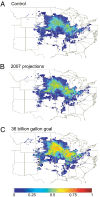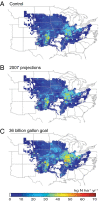Corn-based ethanol production compromises goal of reducing nitrogen export by the Mississippi River
- PMID: 18332435
- PMCID: PMC2393748
- DOI: 10.1073/pnas.0708300105
Corn-based ethanol production compromises goal of reducing nitrogen export by the Mississippi River
Abstract
Corn cultivation in the United States is expected to increase to meet demand for ethanol. Nitrogen leaching from fertilized corn fields to the Mississippi-Atchafalaya River system is a primary cause of the bottom-water hypoxia that develops on the continental shelf of the northern Gulf of Mexico each summer. In this study, we combine agricultural land use scenarios with physically based models of terrestrial and aquatic nitrogen to examine the effect of present and future expansion of corn-based ethanol production on nitrogen export by the Mississippi and Atchafalaya Rivers to the Gulf of Mexico. The results show that the increase in corn cultivation required to meet the goal of 15-36 billion gallons of renewable fuels by the year 2022 suggested by a recent U.S. Senate energy policy would increase the annual average flux of dissolved inorganic nitrogen (DIN) export by the Mississippi and Atchafalaya Rivers by 10-34%. Generating 15 billion gallons of corn-based ethanol by the year 2022 will increase the odds that annual DIN export exceeds the target set for reducing hypoxia in the Gulf of Mexico to >95%. Examination of extreme mitigation options shows that expanding corn-based ethanol production would make the already difficult challenges of reducing nitrogen export to the Gulf of Mexico and the extent of hypoxia practically impossible without large shifts in food production and agricultural management.
Conflict of interest statement
The authors declare no conflict of interest.
Figures





References
-
- U.S. Department of Agriculture. Prospecting Plantings. Washington, DC: Natl Agric Stat Service; 2007.
-
- U.S. Department of Agriculture. USDA Agricultural Projections to 2016. Washington, DC: Office of the Chief Economist; 2007.
-
- U.S. Senate. Renewable Fuels, Consumer Protection, and Energy Efficiency Act of 2007 (S. 1419) Washington, DC: U.S. Senate; 2007. June 21, 2007.
-
- Donner SD, Kucharik CJ, Foley JA. Global Biogeochem Cycles. 2004 doi: 10.1029/2003GB002093. - DOI
-
- Turner RE, Rabalais NN. Nature. 1994;368:619–621.
MeSH terms
Substances
LinkOut - more resources
Full Text Sources

